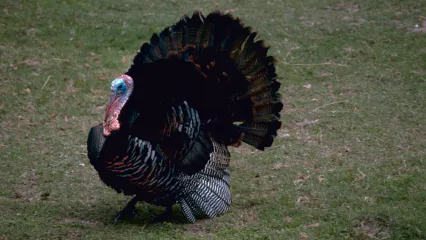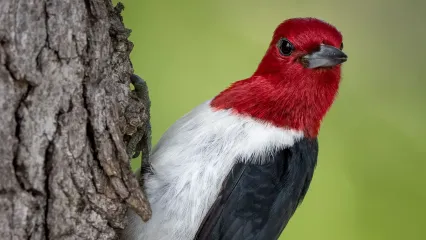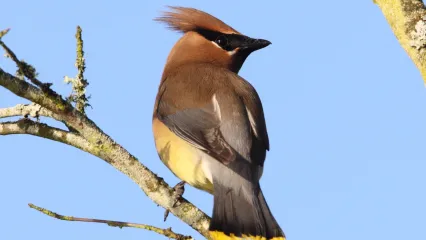
Description
Wild turkey are native to North America and there are five subspecies: Eastern, Osceola (Florida), Rio Grande, Merriam's and Gould's. Oklahoma is home primarily to Eastern and Rio Grande turkeys. Distinguishing between the two may seem difficult, but there are several giveaways. The biggest clue is location. ln Oklahoma, Rio Grande turkeys are found statewide - especially in central and western portions - whereas Easterns are found primarily in the fur eastern third of the state. Additionally, Easterns are larger than Rio Grandes.
Another primary difference between the two is the coloration of male birds. The longer tail feathers of the Eastern turkey are tipped with a dark chocolate color, whereas on a Rio they are generally a lighter shade. At the bases of these long tail feathers are shorter feathers that are a chestnut brown on Easterns and more of a yellowish or buff color on Rio Grandes.
Adult turkeys have between 5,000 and 6,000 feathers covering their body. Male turkeys, also known as toms or gobblers, are much more colorful than hens. They have a beautiful metallic sheen to their feathers called "iridescence." There are two other major characteristics that distinguish males from females. The most noticeable feature is the tuft of modified feathers growing from the tom's chest called a beard. The average beard length for an adult male is nine inches but the longest beard on record reached an incredible 18 inches. Males also have a bony spur on the back of their leg. They use this spur for defense and to establish dominance. The heads of turkeys are featherless, except females which have small feathers for camouflage. Fleshy growths known as caruncles grow on the heads of both males and females. They also have snoods, which are the fleshy protrusions hanging over their bills that can be extended or contracted. The snood of an adult male is usually much larger than that of a female.
The wild turkey's excellent eyesight is its main line of defense. Because its eyes are situated on the sides of the head, it allows it to see two objects at once. It also has a wide field of vision and by twisting the neck, it can gain a 360-degree field of view. Turkeys can see much better than humans. They arc able to see fine detail on even the smallest of objects, hence why many turkey hunters wear head nets. They are also able to pinpoint sounds from a mile away. The feet and beak on a turkey arc also highly sensitive. This helps them "feel" their food or other objects.
Size
Eastern turkeys are the largest subspecies of wild turkeys. Adult males can be up to 4 feet tall weighing more than 20 pounds. Hens are almost as tall as the male but weigh between 8 and 12 lbs.
Habitat
The eastern wild turkey is found in hardwood and mixed forests from New England and southern Canada and northern Florida in the east to Texas, Missouri, Iowa, and Minnesota in the west.
Life Cycle
Increased daylight during the spring signals the start of mating season for wild turkeys. Males begin to gobble between February and l\larch hoping to attract a female. Courtship rakes place when turkeys are still in flocks, and males may mate with several hens. Before sunrise, the tom will gobble from his roost and try to attract several hens before he flies down. Once on the ground, he begins his courtship display by gobbling and strutting. He raises his body feathers, fans his tail, and drops his wings alongside to the ground. Blood rushes to the gobbler's head, his snood elongates and his caruncles turn a bright red. A single mating is sufficient co fertilize all eggs, but hens usually mate several times. After mating, the hens search for a nest sire, and they lay their eggs. Nests are usually made in shallow depressions surrounded by woody covering for protection. Hens lay a clutch of 10 to 12 eggs during a two-week period, usually laying one egg per day. She will incubate her eggs for about 28 days, occasionally turning and rearranging them until they are ready co hatch. A newly-hatched flock must be ready to leave the nest within 12 to 24 hours to feed.

